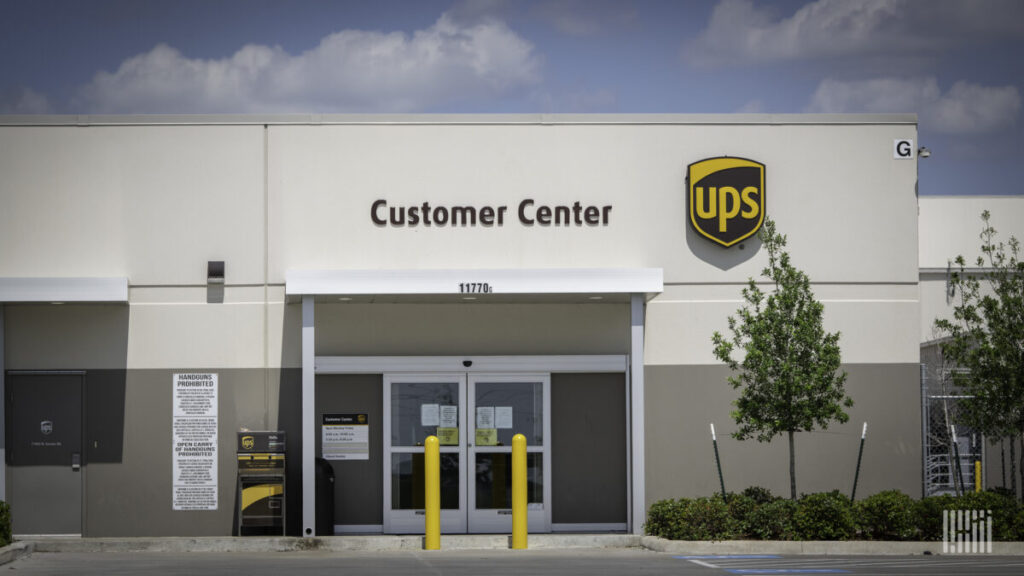UPS is consolidating some of its package operations to improve efficiency. (Photo: Jim Allen/FreightWaves)
UPS’s domestic package volume grew in the second quarter for the first time since late 2021, but its shares fell 13% late Tuesday after revenue and operating profit fell short of analysts’ expectations and the package logistics company tightened its full-year guidance.
UPS now forecasts 2024 revenue of $93 billion, compared with a previous forecast of up to $94.5 billion, and capital spending of $4 billion, $500 million less than before.
It’s been a busy few weeks for UPS (NYSE: UPS). The company announced Monday that it has signed an agreement to acquire Mexican express delivery and logistics company Estafeta to capitalize on the nearshoring trend and increase its logistics capabilities in Mexico. The acquisition is expected to close by the end of the year, based on a 2020 commercial agreement between the two companies.
UPS promoted Brian Dykes to chief financial officer earlier this month, replacing Brian Newman, who resigned for health reasons. In June, the company announced it was selling its truck brokerage business Coyote Logistics to RXO for $1 billion, $750 million less than it paid for the company in 2015.
UPS is also beginning to see increased volume under its new domestic air cargo contract with the U.S. Postal Service as the transition from FedEx progresses ahead of the official start date of October 1.
The Atlanta-based logistics consolidator on Tuesday reported second-quarter operating revenue of $21.8 billion, $440 million below expectations and down 1% from the same period a year ago. Adjusted operating income was $2 billion, down 29.3% from a year ago and 11% below market expectations.
The miss was mainly in the U.S. domestic division, which reported operating income of $997 million, 18% below expectations. Domestic revenue was down 2% year over year, mainly due to shippers switching from premium express to less expensive ground shipping and favoring SurePost over ground shipping, resulting in a 3% decrease in average revenue per piece. UPS SurePost is an economy service that hands off packages to the U.S. Postal Service for final-mile delivery. As a result, average daily air volumes decreased 7.8%, while ground volumes increased 2.3% and SurePost daily volumes increased 25%.
“We’re seeing an acceleration of new e-commerce customers coming into the market who, frankly, operate different models than our traditional customers and are taking great advantage of our SurePost product,” Dykes said on a conference call with analysts.
The company’s contract logistics and freight forwarding business, Supply Chain Solutions, reported operating profit of $234 million, 21.4% below market expectations.
The story continues
Better than expected international results couldn’t offset the performance of other segments, which slightly beat expectations and reported pre-tax profits of $824 million on revenues up 6% year over year as improved profitability overcame lower volumes.
International cargo volumes increased due to strong e-commerce demand, particularly from China, and rising freight rates as market demand outpaced shipping capacity. However, ocean freight volumes and revenues declined year-over-year.
UPS said it closed 35 sorting operations, including five buildings, in the first half of the year and plans to close five more this year as part of a five-year redesign of its network. It also reduced its delivery staff by 26% during the quarter by automating delivery processes for package cars and feeder drivers.
(Photo: Jim Allen/FreightWaves)
CEO Carol Tomé said UPS has recently strengthened its international network in Taiwan and Europe. The company expanded its pickup capacity in Taiwan by 30% and extended pickup hours until late at night to help Taiwanese companies, including those in high-tech manufacturing and automotive, reach key European markets within two days. Meanwhile, it expanded space by 25% at its distribution facility near Frankfurt Airport in Germany to better support intermodal shipments to Central Europe’s growing technology and healthcare industries.
Management said in March that the first half of the year would be the toughest, with profits expected to fall 30% year over year but then turn to growth in the final two quarters as upfront cost increases from last year’s Teamsters labor contract fade. The revised guidance suggests that the economic environment for freight shipping is improving but headwinds remain significant.
Tomé acknowledged that his B2B business has yet to fully recover from the Teamsters contract negotiations, which he said caused many customers to flee to other carriers to avoid a strike that could disrupt deliveries.
UPS announced that it has paid $94 million to settle a challenge by Italian tax authorities to the deductibility of value-added tax the company paid to certain third-party service providers.
Recommended reading:
U.S. Postal Service to shift air shipments to UPS this summer
The post UPS domestic revenue declines as customers switch to economy service appeared first on FreightWaves.

